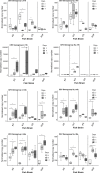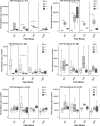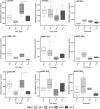Immune responses in carp strains with different susceptibility to carp edema virus disease
- PMID: 37465154
- PMCID: PMC10351508
- DOI: 10.7717/peerj.15614
Immune responses in carp strains with different susceptibility to carp edema virus disease
Abstract
Carp edema virus disease (CEVD), also known as koi sleepy disease (KSD), represents a serious threat to the carp industry. The expression of immune-related genes to CEV infections could lead to the selection of crucial biomarkers of the development of the disease. The expression of a total of eleven immune-related genes encoding cytokines (IL-1β, IL-10, IL-6a, and TNF-α2), antiviral response (Mx2), cellular receptors (CD4, CD8b1, and GzmA), immunoglobulin (IgM), and genes encoding-mucins was monitored in gills of four differently KSD-susceptible strains of carp (Amur wild carp, Amur Sasan, AS; Ropsha scaly carp, Rop; Prerov scaly carp, PS; and koi) on days 6 and 11 post-infection. Carp strains were infected through two cohabitation infection trials with CEV genogroups I or IIa. The results showed that during the infection with both CEV genogroups, KSD-susceptible koi induced an innate immune response with significant up-regulation (p < 0.05) of IL-1β, IL-10, IL-6a, and TNF-α2 genes on both 6 and 11 days post-infection (dpi) compared to the fish sampled on day 0. Compared to koi, AS and Rop strains showed up-regulation of IL-6a and TNF-α2 but no other cytokine genes. During the infection with CEV genogroup IIa, Mx2 was significantly up-regulated in all strains and peaked on 6 dpi in AS, PS, and Rop. In koi, it remained high until 11 dpi. With genogroup I infection, Mx2 was up-expressed in koi on 6 dpi and in PS on both 6 and 11 dpi. No significant differences were noticed in selected mucin genes expression measured in gills of any carp strains exposed to both CEV genogroups. During both CEV genogroups infections, the expression levels of most of the genes for T cell response, including CD4, CD8b1, and GzmA were down-regulated in AS and koi at all time points compared to day 0 control. The expression data for the above experimental trials suggest that both CEV genogroups infections in common carp strains lead to activation of the same expression pattern regardless of the fish's susceptibility towards the virus. The expression of the same genes in AS and koi responding to CEV genogroup IIa infection in mucosal tissues such as gill, gut, and skin showed the significant up-regulation of all the cytokine genes in gill and gut tissues from koi carp at 5 dpi. Significant down-regulation of CD4 and GzmA levels were only detected in koi gill on 5 dpi but not in other tissues. AS carp displayed significant up-expression of Mx2 gene in all mucosal tissues on 5 dpi, whereas in koi, it was up-regulated in gill and gut only. In both carp strains, gill harbored a higher virus load on 5 dpi compared to the other tissues. The results showed that resistance to CEV could not be linked with the selected immune responses measured. The up-regulation of mRNA expression of most of the selected immune-related genes in koi gill and gut suggests that CEV induces a more systemic mucosal immune response not restricted to the target tissue of gills.
Keywords: Carp edema virus; Common carp; Gene expression; Immune related genes; Mucosal response.
©2023 Baloch et al.
Conflict of interest statement
The authors declare there are no competing interests.
Figures






Similar articles
-
Experimental infections of different carp strains with the carp edema virus (CEV) give insights into the infection biology of the virus and indicate possible solutions to problems caused by koi sleepy disease (KSD) in carp aquaculture.Vet Res. 2017 Feb 21;48(1):12. doi: 10.1186/s13567-017-0416-7. Vet Res. 2017. PMID: 28222784 Free PMC article.
-
Fish immune responses to natural infection with carp edema virus (Koi sleepy disease): An emerging fish disease in India.Fish Shellfish Immunol. 2022 Nov;130:624-634. doi: 10.1016/j.fsi.2022.09.012. Epub 2022 Sep 17. Fish Shellfish Immunol. 2022. PMID: 36126841
-
It is everywhere-A survey on the presence of carp edema virus in carp populations in Germany.Transbound Emerg Dis. 2022 Jul;69(4):2227-2241. doi: 10.1111/tbed.14225. Epub 2021 Jul 20. Transbound Emerg Dis. 2022. PMID: 34231974
-
Emergence of carp edema virus (CEV) and its significance to European common carp and koi Cyprinus carpio.Dis Aquat Organ. 2017 Oct 18;126(2):155-166. doi: 10.3354/dao03164. Dis Aquat Organ. 2017. PMID: 29044045 Review.
-
Carp edema virus and immune response in carp (Cyprinus carpio): Current knowledge.J Fish Dis. 2021 Apr;44(4):371-378. doi: 10.1111/jfd.13335. Epub 2021 Jan 18. J Fish Dis. 2021. PMID: 33460151 Review.
Cited by
-
Mucosal affairs: glycosylation and expression changes of gill goblet cells and mucins in a fish-polyopisthocotylidan interaction.Front Vet Sci. 2024 Apr 9;11:1347707. doi: 10.3389/fvets.2024.1347707. eCollection 2024. Front Vet Sci. 2024. PMID: 38655531 Free PMC article.
-
Cecropin anisaxin-2S has in vitro immunomodulatory, but not antiproliferative and antiviral properties.Front Immunol. 2025 May 5;16:1567505. doi: 10.3389/fimmu.2025.1567505. eCollection 2025. Front Immunol. 2025. PMID: 40391212 Free PMC article.
References
-
- Adamek M, Matras M, Dawson A, Piackova V, Gela D, Kocour M, Adamek J, Kaminski R, Rakus K, Bergmann SM, Stachnik M, Reichert M, Steinhagen D. Type I interferon responses of common carp strains with different levels of resistance to koi herpesvirus disease during infection with CyHV-3 or SVCV. Fish and Shellfish Immunology. 2019;87:809–819. doi: 10.1016/j.fsi.2019.02.022. - DOI - PubMed
-
- Adamek M, Matras M, Rebl A, Stachnik M, Falco A, Bauer J, Miebach AC, Teitge F, Jung-Schroers V, Abdullah M, Krebs T, Schröder L, Fuchs W, Reichert M, Steinhagen D. Don’t let it get under your skin!—vaccination protects the skin barrier of common carp from disruption caused by cyprinid herpesvirus 3. Frontiers in Immunology. 2022a;13:1–19. doi: 10.3389/fimmu.2022.787021. - DOI - PMC - PubMed
Publication types
MeSH terms
Substances
LinkOut - more resources
Full Text Sources
Research Materials

